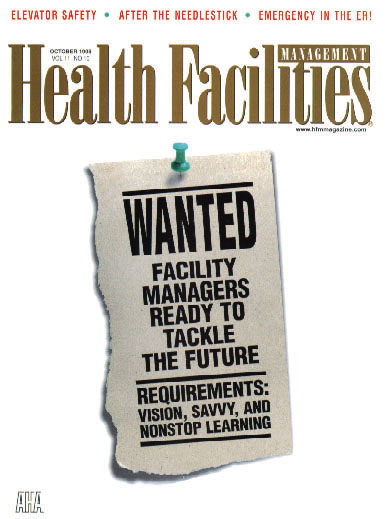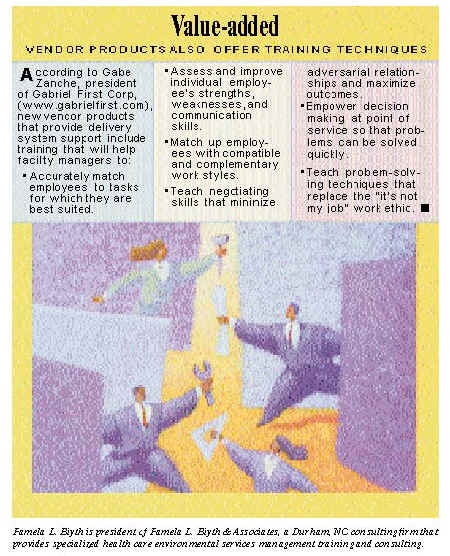

An article written by Pamela L. Blyth in the October 1998 issue of Health Facilities Management...(magazine cover and back page of article loading at the bottom of page)
Attention, shoppers!
Smart tips on how to wade through ‘new, improved products’.
Just like other harried shoppers, environmental services professionals are always on the lookout for “new, improved” products that will “clean more with less.” Though manufacturers invest big bucks in research and development, new products may provide only part of a solution by improving quality or cutting costs. But for a well-organized and well-managed housekeeping department, the cost of chemicals or equipment is only a fraction of the total cost of the operation. And “quality” is frustratingly subjective.
Of course it’s important to identify any new products that can improve outcomes. Floor finishes that stand up to more abuse, require less refinishing or dry faster will always find a market. Improved surfactants that reduce film or residue-and therefore the cleaning frequency-should top any manager’s shopping list. Better chemical concentrates that are actually “more concentrated” (some are now down from 3 to 4 ounces to 1/2 - 3/4 ounces per gallon) can mean you’re buying less water and more cleaning power for about the same cost. Interior finishes, such as carpet fibers that repel more dirt longer and that will maintain their appearance despite frequent, and often aggressive, cleaning are being constantly developed. But do such products really increase productivity?
What’s a ‘labor
saver’?
The labor-saving characteristics of any chemical or equipment product are
critical to housekeeping operations-especially in health care environments. While
that may seem obvious, what isn’t always so obvious is the disconnect that can exist
between how mangers often define “labor-saving” and the approach used to achieve
it. Managers continue to try to reduce the labor costs by using products that do a
thorough job (reduced frequencies) or that cost less to buy and use (reduced supply
costs). That approach often does save some time and money.
But unfortunately, no matter how cost-effective chemicals, equipment, and other supplies become, they will never produce the dollar savings that can be realized by more efficient labor. That’s why employees must be given top-notch training and support. Truly productive employees have been trained to value a strong work ethic and empowered to make decisions about service delivery, regardless of what tools they use. They are our first “customers.” They depend on the facility to identify and provide the products or training they need to achieve the outcomes required.
“Labor-saving” products are no substitute for a workforce that works smarter and more effectively. Today’s newest and most valuable products are those that help improve the department’s management skills, foster communication, develop productive interpersonal relationships, and understand teamwork and the value of group commitment to common outcomes. In other words, the “hot” products in today’s housekeeping market are those that build effective, results-oriented systems
There are many resources for training support products available to managers. Professional organizations - such as the American Society for Healthcare Environmental Services (ASHES) - publish helpful resource information and conduct educational seminars. Vendors, who know that the value of their chemicals and equipment is directly related to proper use, have offered onsite technical training for years. And consultants have traditionally provided a wide array of customized ideas, approaches and management support.
Now, however, more and more vendors are realizing they need to provide more than just technical expertise - they realize that the effectiveness of any product is dependent on the operational management of the department. And they understand the need for individual employees to have the skills that will enable them to help implement an effective service delivery system.
More and more manufacturers and distributors are seeking to actively provide this kind of consulting support, either through their own staff or through partnerships with independent consultants. Whatever the mechanism for delivering this kind of operational support, the onsite manager and departmental staff stand to benefit considerably.
“Value-added” products that help managers to develop and implement operational systems (or effective vehicles for service delivery) should be a part of every manager’s shopping list. Chemicals and equipment are important, but how we use them and the ability of employees to use them within an effective service delivery system is even more essential to success.
What’s the upshot?
What this means is a big change in how we deliver services. We’ll always need
to identify products that reduce labor and produce better results (glass cleaners that
don’t leave a film, for example). And we’ll always have to make sure that
all employees understand the proper way to use those products. But unless we begin
to think of the personal and behavioral skills required to deliver service, we’ll
never achieve that goal of “doing more with less.”
The newest and most innovative products aren’t really chemicals and equipment at all. The basic nature of “dirt” hasn’t changed in millions of years; and the chemistry and physics of soil removal is basically the same. With the exception of minor enhancements, we’re not going to see a major shift in the technology and science of soil removal
The new products - some of them available now - will focus on the non-tangible factors that can create an efficient and effective workforce. Value-adds that offer personality and work-style preference evaluations, interpersonal skills development, decision making and problem-solving techniques, and how to focus on common goals will become the products of choice for many hospitals.
So attention, shoppers! Check your shopping list and take stock of the skills your departments may need.


Go back to magazine articles about Gabriel
Copyright © 2006 Gabriel First Corp.